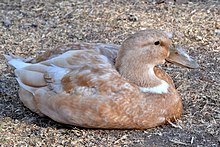 A female at Hahn Park, California | |
| Conservation status | RBST (UK): at risk |
|---|---|
| Country of origin | United Kingdom |
| Use | meat,eggs |
| Traits | |
| Skin color | Buff, Blond and Brown |
| Classification | |
| PCGB | light[1] |
| |
The Orpington[2] or Buff Orpington Duck is a breed of domestic duck. It is a dual-purpose breed used for meat and egg production. It is capable of laying up to 220 eggs a year. Originally created by William Cook of Orpington, Kent, England, from the selection of mis-marked Blue Orpington Ducks; Cook was also the developer of the Orpington chicken. The breeds used in the development of the breed included Cayuga, Indian Runner, commercial Aylesbury and Rouen. It is proposed that Cook's intentions for the breed were to capitalize on the growing demand for the buff colour pattern.[3] The Buff Orpington Duck was introduced to the public at the Dairy Show, the Agricultural Hall (q.v.), Islington, London in October 1897.[4] It is considered a threatened breed by the ALBC. This breed was admitted to the British Poultry Standard in 1910 and the American Poultry Associations Standard of Perfection as the 'Buff Duck' in the Medium class in 1914. The Orpington duck is available in three colour varieties: Buff, Blond and Brown. The Buff Orpington is an unstable colour due to a blue dilution gene which means that from the offspring, all three colour variations will appear.[5]
- ^ Cite error: The named reference
pcgbwas invoked but never defined (see the help page). - ^ The Poultry Club of Great Britain: Orpington Archived 2014-07-15 at the Wayback Machine
- ^ Holderread, Dave (2001). Storey's Guide to Raising Ducks. North Adams, MA, USA: Storey Publishing. pp. 60, 61.
- ^ Cook, W.(1897) The Poultry Journal. p.81-82
- ^ "Orpington Ducks". 20 January 2015.